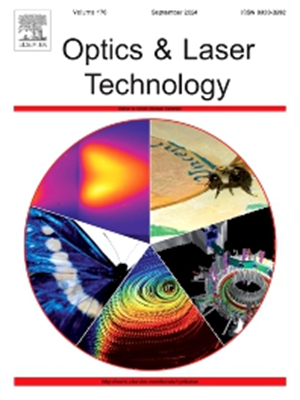A molecular dynamics model for studying the effect of picosecond laser pulse overlap on silicon carbide ablation processing
IF 5
2区 物理与天体物理
Q1 OPTICS
引用次数: 0
Abstract
A high-precision molecular dynamic model of single pulse picosecond laser ablation of silicon carbide crystal is constructed by introducing one thousandth laser focal spot diameter and adjusting the appropriate coupling coefficient, and the correlation between the nanoscale simulation and microscale experimental reproduction is achieved. After that, in order to establish a precise correlation between scanning speed and the effective pulse number, a laser intensity correction factor for charactering the attenuation of Gaussian light over distance is introduced. When the scanning speed is 300.00, 200.00 and 100.00 mm/s, the intensity-corrected pulse overlap rate is 106 %, 156 % and 230 %, which is converted to an effective pulse number of 1.06, 1.56 and 2.30, respectively. The calculated effective pulse number is used as an input to the molecular dynamic model. The high-precision molecular dynamics model with the input of effective pulse number is then used to simulate the effects of pulse overlap rate and laser fluence on the ablation results. By comparing the calculated ablation widths with the experimental detection results, the accuracy of the model study pulse overlap rate and laser fluence ablation results are both proved to be higher than 95 %, and the average error between the experimental and simulation methods are both proved to be less than 1 %.
研究皮秒激光脉冲重叠对碳化硅烧蚀加工影响的分子动力学模型
通过引入千分之一激光焦斑直径,调整适当的耦合系数,建立了单脉冲皮秒激光烧蚀碳化硅晶体的高精度分子动力学模型,实现了纳米尺度模拟与微尺度实验再现的关联。然后,为了建立扫描速度与有效脉冲数之间的精确相关性,引入了表征高斯光随距离衰减的激光强度校正因子。当扫描速度为300.00、200.00和100.00 mm/s时,经强度校正后的脉冲重叠率分别为106%、156%和230%,有效脉冲数分别为1.06、1.56和2.30。计算得到的有效脉冲数作为分子动力学模型的输入。采用输入有效脉冲数的高精度分子动力学模型,模拟了脉冲重叠率和激光辐照度对烧蚀结果的影响。通过将计算得到的烧蚀宽度与实验检测结果进行对比,验证了模型研究脉冲重叠率和激光能量流烧蚀结果的精度均大于95%,实验方法与仿真方法的平均误差均小于1%。
本文章由计算机程序翻译,如有差异,请以英文原文为准。
求助全文
约1分钟内获得全文
求助全文
来源期刊
CiteScore
8.50
自引率
10.00%
发文量
1060
审稿时长
3.4 months
期刊介绍:
Optics & Laser Technology aims to provide a vehicle for the publication of a broad range of high quality research and review papers in those fields of scientific and engineering research appertaining to the development and application of the technology of optics and lasers. Papers describing original work in these areas are submitted to rigorous refereeing prior to acceptance for publication.
The scope of Optics & Laser Technology encompasses, but is not restricted to, the following areas:
•development in all types of lasers
•developments in optoelectronic devices and photonics
•developments in new photonics and optical concepts
•developments in conventional optics, optical instruments and components
•techniques of optical metrology, including interferometry and optical fibre sensors
•LIDAR and other non-contact optical measurement techniques, including optical methods in heat and fluid flow
•applications of lasers to materials processing, optical NDT display (including holography) and optical communication
•research and development in the field of laser safety including studies of hazards resulting from the applications of lasers (laser safety, hazards of laser fume)
•developments in optical computing and optical information processing
•developments in new optical materials
•developments in new optical characterization methods and techniques
•developments in quantum optics
•developments in light assisted micro and nanofabrication methods and techniques
•developments in nanophotonics and biophotonics
•developments in imaging processing and systems

 求助内容:
求助内容: 应助结果提醒方式:
应助结果提醒方式:


